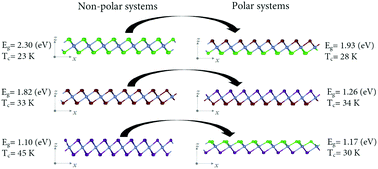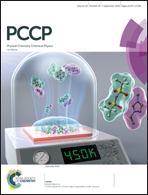A 2D ferromagnetic semiconductor in monolayer Cr-trihalide and its Janus structures
Abstract
Using first principles calculations, we explored the physical properties of two-dimensional (2D) Cr-trihalide X3–Cr2–X3 or CrX3 (X = Cl, Br, I) and its Janus monolayers X3–Cr2–Y3 (X and Y = Cl, Br, I) where X ≠ Y. We found that Janus monolayer X3–Cr2–Y3 materials are dynamically stable and that it is feasible to synthesize X3–M2–Y3 2D-crystals. Both pristine and Janus layers have intrinsic two-dimensional ferromagnetic semiconducting band structures; the largest band gap of 2.3 eV was found in Cl3–Cr2–Cl3, while the band gaps decreased in heavier halide systems. Using Monte Carlo simulations, we found that the Curie temperatures (Tc) showed the same feature of strong dependence on the X and Y halides. In non-polar systems with X = Y, we found no dipole moment, while the polar systems with X ≠ Y had induced dipole moments. Thus, the pristine layer has the same function on both sides, while the Janus layer displays dissimilar work functions in two different surface directions; this was related to the dipole moment and the value of electronegativity. We found that both pristine and Janus layer systems displayed rather weak frequency-dependent dielectric functions. Thus, the variation of the refractive index with frequency was small, and almost zero reflectivity was found in all systems.



 Please wait while we load your content...
Please wait while we load your content...